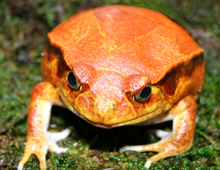Description: Tomato frogs are sexually dimorphic. The common name comes from the “tomato” red color of the female, with males being less brilliantly colored. Their undersides are pale; have a black eye line; and green eyes. Juveniles are brown in color. The color of the adult frogs indicates they can secrete an unpleasant substance when seized, in this case a thick, mildly toxic mucus. The frogs in the Microhylidae family are known as the “narrow- mouth frogs.”
Size: Males are about one-third the weight of the females. Females are four inches (10.5 cm) in length; males are 2.5 inches (6.5 cm) long.
Behavior: They walk or hop about and are not good swimmers. They do not move about, preferring to remain at a selected site, often close to areas of shallow water. Tomato frogs are terrestrial and nocturnal, burying themselves during the day and coming out at night when they become ambush predators, waiting for food to walk by.
Diet: They are primarily insectivores but will feed on any small animals it can catch if needed.
Communication: During the rainy season, males can be heard croaking from shallow pools of water, ditches or marshes as they try to call females with which to breed.
Reproduction: After the male successfully attracts a mate, breeding usually takes place in slow- moving or stagnant water, resulting in up to 15,000 black and white eggs being laid on the water. They hatch within 36 hours, with metamorphosis being completed in about 45 days.
Habitat/range: They live in moist lowland forests, rivers, marshes, swamps, ditches and ponds along the northeastern coast of Madagascar from Antongil Bay to Andevoranto.
Status: Listed as Near Threatened on the IUCN Red List; CITES, Appendix I.



